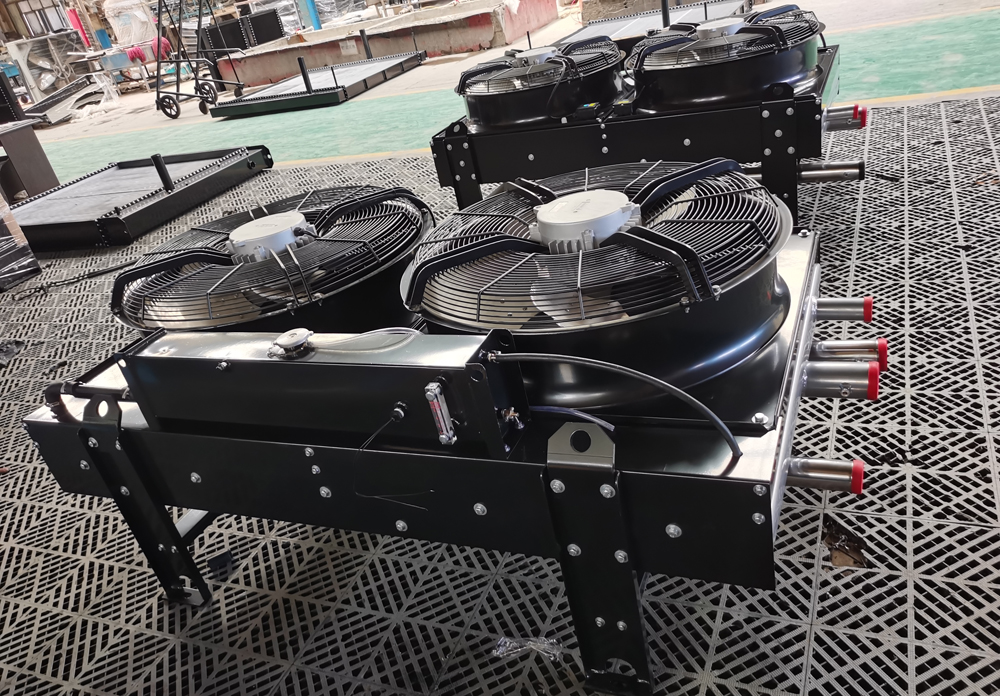The remote radiator and split radiator are two different cooling system configurations for diesel generator sets, primarily differing in layout design and installation methods. Below is a detailed comparison:
1. Remote Radiator
Definition: The radiator is installed separately from the generator set and connected via pipelines, typically placed at a distant location (e.g., outdoors or on a rooftop).
Features:
- The radiator operates independently, with coolant circulated through fans, pumps, and pipelines.
- Suitable for confined spaces or environments where reducing engine room temperature is necessary.
Advantages:
- Better Heat Dissipation: Prevents hot air recirculation, improving cooling efficiency.
- Saves Space: Ideal for compact installations.
- Reduced Noise: The radiator fan noise is isolated from the generator.
- High Flexibility: Radiator placement can be adjusted based on site conditions.
Disadvantages:
- Higher Cost: Requires additional pipelines, pumps, and installation work.
- Complex Maintenance: Potential pipeline leaks require regular inspections.
- Dependent on Pump: Cooling system fails if the pump malfunctions.
Applications:
Small engine rooms, noise-sensitive areas (e.g., data centers), or high-temperature environments.
2. Split Radiator
Definition: The radiator is installed separately from the generator but at a closer distance (usually within the same room or adjacent area), connected via short pipelines.
Features:
- The radiator is detached but does not require long-distance piping, offering a more compact structure.
Advantages:
- Balanced Performance: Combines efficient cooling with easier installation.
- Easier Maintenance: Shorter pipelines reduce failure risks.
- Moderate Cost: More economical than a remote radiator.
Disadvantages:
- Still Occupies Space: Requires dedicated space for the radiator.
- Limited Cooling Efficiency: May be affected if the engine room lacks proper ventilation.
Applications:
Medium/small generator sets, well-ventilated engine rooms, or outdoor containerized units.
3. Summary Comparison
| Aspect | Remote Radiator | Split Radiator |
|---|---|---|
| Installation Distance | Long-distance (e.g., outdoors) | Short-distance (same room/adjacent) |
| Cooling Efficiency | High (avoids heat recirculation) | Moderate (depends on ventilation) |
| Cost | High (pipes, pumps) | Lower |
| Maintenance Difficulty | Higher (long pipelines) | Lower |
| Best For | Space-constrained, high-temperature areas | Standard engine rooms or outdoor containers |
4. Selection Recommendations
- Choose Remote Radiator if:
- The engine room is small.
- Ambient temperatures are high.
- Noise reduction is critical (e.g., hospitals, data centers).
- Choose Split Radiator if:
- Budget is limited.
- The engine room has good ventilation.
- The generator set has medium/low power.
Additional Notes:
- For remote radiators, ensure pipeline insulation (in cold climates) and pump reliability.
- For split radiators, optimize engine room ventilation to prevent heat buildup.
Select the appropriate configuration based on cooling efficiency, cost, and maintenance requirements.
Post time: Aug-05-2025

















